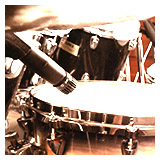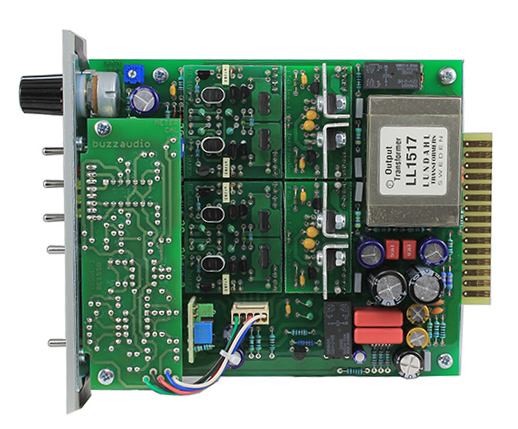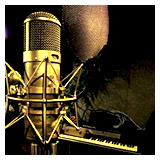 | US$810 | €725 | £650 |
| US$810 | €725 | £650 |


All discrete signal path using our True Class A BE40 amplifiers at the input and BE50 high current line drivers to excite the Lundahl LL1517 output transformer. The topology is quite different to most other mic preamps in that it is balanced from input to output. The instrument input features our BE43 "bootstrapped FET" high impedance interface that really pumps as a bass DI.
The Elixir is an ideal compliment to other 500 series preamps that feature a dark or middly sound. The wide frequency response and fast transient response plus color from the output transformer generate a "warm sweet liquid" sound quality that sets it apart from that crowd. These attributes make the Elixir particulary good at recording percussion, drums (you need to hear it on snare), vocals and stringed instruments. When used at high gains and high output levels the sound of the Elixir does not turn "dirty", unlike preamps with poor slew rate performance thereby generating dynamic distortions.
As with all our preamps, the Elixir noise floor is as low as we can make it under the laws of physics and there is plenty of gain for low output ribbon and dynamic microphones. The output headroom at +34dBu is outstandingly unique in the 500 series format, and adds a feeling of real effortlessness to the sound quality. The transformer-less mic input presents a "non-reactive" load to the microphone which means you hear exactly what the microphone manufacturer intended, without the unpredictable nature of an input transformer.
![]() Other 500 series modules - Essence opto compressor | Tonic inductor equalizer
Other 500 series modules - Essence opto compressor | Tonic inductor equalizer
![]() GAIN - 41 detented pot that sets gain between +22 to +70dB.
GAIN - 41 detented pot that sets gain between +22 to +70dB.
![]() POLARITY - normal or reverse polarity switched at the input inverts the signal 180 degrees, used to match spaced microphones such as top and bottom snare drum..
POLARITY - normal or reverse polarity switched at the input inverts the signal 180 degrees, used to match spaced microphones such as top and bottom snare drum..
![]() 20dB PAD - this switch introduces a 20dB pad right at the mic input for high level signals. Because it is part of the input circuit network, using the pad does not change the sound of the preamplifier.
20dB PAD - this switch introduces a 20dB pad right at the mic input for high level signals. Because it is part of the input circuit network, using the pad does not change the sound of the preamplifier.
![]() IMPEDANCE - selects high or low input impedance. For the mic input it is 3kohms or 1kohms. There is no right or wrong setting for this function but it can change the tone of dynamic and ribbon microphones. When using the DI input it is switched 1MEG ohms or 20k ohms, which may similarily alter the tone of bass or guitar pickups.
IMPEDANCE - selects high or low input impedance. For the mic input it is 3kohms or 1kohms. There is no right or wrong setting for this function but it can change the tone of dynamic and ribbon microphones. When using the DI input it is switched 1MEG ohms or 20k ohms, which may similarily alter the tone of bass or guitar pickups.
![]() +48V - switches on the phantom power for condensor microphones and powered DI boxes.
+48V - switches on the phantom power for condensor microphones and powered DI boxes.
![]() METER - four leds give visual indication of peak output level.
METER - four leds give visual indication of peak output level.


Finally got a chance to test out the Elixir preamps at my friend's studio in Auckland. Can't overstate how much I loved them!! We A/B tested them against his Rupert Neve 517 (which I had been planning to buy, before I heard about the Elixir), and the difference was really clear. Nothing against the Rupert Neve pre, it just had a more midrange-focussed, vintage-style sound as opposed to the open, crisp character of the Elixir. Couldn't be happier with my choice! Pretty sure my friend wants to buy one too now. [2024]
The Buzz Audio Elixir 500 series preamp has become my primary choice for almost any source. I have a pair of these, and there is nothing they cannot capture! I find the transient response to be very quick and accurate, but unlike some of my other preamps with this capability, the Elixir allows the lows and mids to breathe very naturally at the same time. This balance is especially ideal for any source with a wide frequency range (piano, drums, strings). For vocals, whatever I put into the preamp, it captures for me. I also reach for these preamps when tracking guitar and bass, when I want to capture a rich and clean sound.

The extra features on this preamp have also proved to be very useful. The stepped pots allow me to dial in a perfect stereo match, the pads allow me to use some of my high gain condensers on loud sources and the impedance switch allows me to dial in some warmth and slightly wider low end response when the source needs a bit of help in that range. One final feature that deserves credit as well is the mute function. When I am in front of my rack, and listening to a stereo source, it is so helpful to not have to move over to my DAW and mute to hear the left and right sources in isolation.
These preamps are very clean, but I would not call them sterile in the least. They have their own special character, and it is one that I am growing to love more and more each time I use them.
Lastly, what good is a piece of gear without a company that can back them up. Tim at Buzz Audio is amazing. I had a small issue with one of these units due to the grounding configuration of my 500 series rack. I contacted Tim, and he immediately arranged for a solution. He was gracious, helpful and quick to help me to overcome the issue, and that is an added bonus to using the Buzz audio product line.
Justin Gray website
Min Gain Mic; +22dB (-2dB with pad in)
Max Gain Mic; +70dB
Min Gain Instrument; +12dB (-3dB with pad in)
Max Gain Instrument; +60dB
Maximum Output Level; +34dBu into 3k ohm load
Frequency Response; Mic 10Hz to 300kHz @ 20dB gain (-3dB)
Frequency Response; Instrument 10Hz to 120kHz @ 20dB gain (-3dB)
Slew Rate; 30V/uS @ +20dBu output level
Harmonic Distortion measured at -20dBu input level, gain adjusted for +10dBu output level
Mic; 0.15% @ 100Hz, 0.01% @ 1kHz, 0.005% @ 10kHz
Instrument; 0.15% @ 100Hz, 0.015% @ 1kHz, 0.015% @10kHz
EIN Mic; -132.5dB A wtg, 150ohm source Z
Signal to Noise Ratio Mic; -73dB A wtg, input shorted
Signal to Noise Ratio Instrument; -76dB A wtg, input shorted
CMNR Mic; -78dB @ 100Hz, -100dB @ 1kHz, -100dB @ 10kHz
Input Impedance Mic; 4k ohms/1k2 ohms switchable
Input Impedance Instrument; 1MEG ohms/20k ohms switchable
Size; (37Wx132H). Fits 1 space in API 500 series rack format
Power requirements; 150mA +/- 15-18 volts DC, as supplied by frame power supply
Specifications are typical of a production unit and are subject to change without notice. 0dBu reference = 0.775 volts RMS
Buzz Audio Ltd
Blenheim
New Zealand
Ph +64(0)3-577-5597
send us an email
